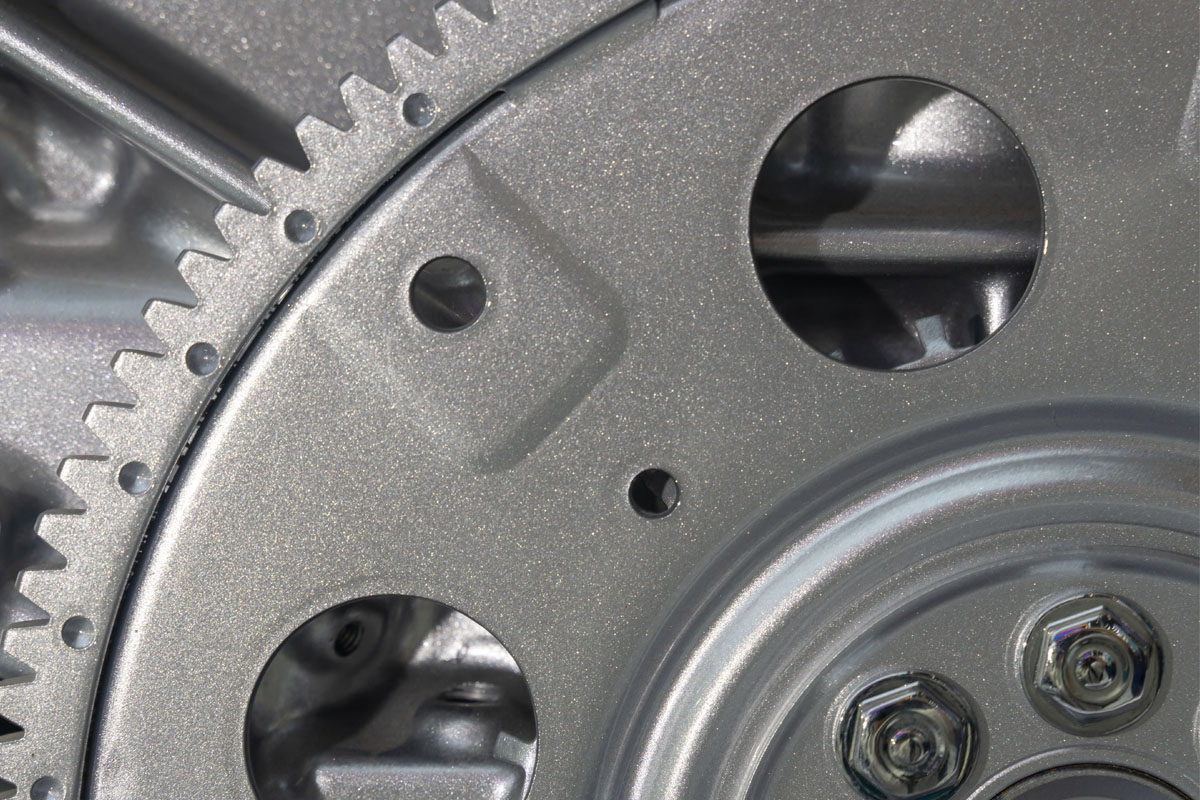In manual vehicles, the flywheel transmits and manages power from the engine going to the manual transmission. However, what is its automatic counterpart?
The flexplate is the next best thing to a flywheel in an automatic vehicle. Nevertheless, it’s not a one-for-one counterpart.
What Is a Flexplate?
Also spelled as flex plate, the flexplate serves as a drive plate of automatic transmissions. This metal disk gets bolted to the crankshaft. Additionally, the torque converter is mounted on the flexplate. Its position and tangible attachment to the engine and transmission allows the part to connect the two automotive systems to one another.
It derives its name from how the thin shape flexes when responding to the energy applied by the crankshaft. This flexibility can make up for gear shifts, irregular power output, and insignificant misalignments between the engine and transmission.
Flexplates comprise of two components, the plate itself and a ring gear. The latter is a toothed gear that goes around the flexplate’s circumference. When starting your vehicle, the ring gear engages with the starter motor, enabling the engine to crank up.
In some vehicle models, the flexplate also integrates the pickup ring of the crankshaft position sensor. Also referred to as the tone ring, the pickup ring is a ring with notches that transmits firing directions to the powertrain control module (PCM). When the pickup ring creates an issue, you are required to replace the flexplate that integrates the crankshaft position sensor.
In a lot of vehicles, the flexplate is made from stamped steel. High-performance vehicles highlight machined billets. Race vehicles utilize a 2-piece billet, whereas dragsters have a 1-piece billet.
What Does It Do?
The flexplate seizes the energy produced by the engine. It stores the gathered energy in its large mass by rotating at an even and sleek speed. At the correct moment, the plate releases the gathered energy to the transmission. The transmission then divides the energy between the drive wheels for propelling your vehicle.
If it has a tone ring, it is going to help the crankshaft position sensor establish the position and RPM of the crank. The PCM uses the output from the crankshaft position sensor for setting the correct time for operations such as ignition and fuel injection.
Common Flexplate Issues
The flexplate is a durable part. It has to withstand the considerable forces delivered by engine power that the plate stores and sends to the torque converter.
Nevertheless, the part’s moniker flexibility only takes it so far. Cracks could form in the flexplate. If you proceed to keep driving without replacing the impaired plate, the part could fail.
Apart from the flexplate, the bolts securing the plate to the crankshaft can come loose up or fall apart. Loose and damaged flexplate bolts are going to cause problems of their own. Thankfully, you can tighten loosened bolts, although you are required to also tighten them in the proper order.
What is the Cause of These Problems?
There are a number of potential reasons behind flexplate problems. For instance, the torque converter or engine could become un-balanced, which impacts the plate’s alignment.
As an alternative, the starter motor might wear out or cause damage to the ring gear when the 2 parts engage throughout the startup process. When the engine is unable to lock with the impaired gear, it might lead to problems like failure to start the engine.
Improperly installed flexplate bolts could also cause issues with the plate. You are required to apply the appropriate amount of torque to the flexplate bolts. Additionally, you are required to tighten the bolts in the manufacturer-specified sequence.
Failing Symptoms
It is a crucial part of the transmission. If it creates a problem, it impacts the rest of the transmission. It’s wise to keep an eye out for the warning signs of a failing flexplate.
Here are some of the most common symptoms of a failing flexplate:
Squealing Noises When Starting the Engine
You can detect a bad flexplate when starting your vehicle. Listen for a metallic sound when the starter motor engages with the flexplate or the torque converter. That squealing sound is a potential symptom that it is having issues.
Unusual Noises When Engine Idle or When Shifting Gears
When leaving your vehicle idling in neutral or in park, do you notice regular clinking or grinding sounds? Or do you notice a knocking when shifting forward or reverse gear?
Strange noises such as clinking, grinding, or knocking when driving could signify a misaligned or distorted flexplate. The plate’s sides have contacted other parts, which is not supposed to happen.
The main common cause of a distorted flexplate is damaged or loose flexplate bolts.
Vibrations While Driving
A failing flexplate could cause your vehicle to vibrate. The faster you drive, the more serious the vibrations become. In many cases, this happens due to a dislodged balancing weight.
Other Symptoms
The following are other potential symptoms of a failing flexplate:
- Rough running engine
- Engine power loss when going faster
- Less than ideal fuel economy
- Whining noise when starting the engine
- Starter bogs down or has difficulty turning
Roadrunner Converters Offers Many Torque Converter Replacements
Roadrunner Converters offers many torque converters for sale online. We offer GM Torque Converters, Ford Torque Converters, Diesel Torque Converters, Towing Torque Converters, Street Torque Converters and more.







